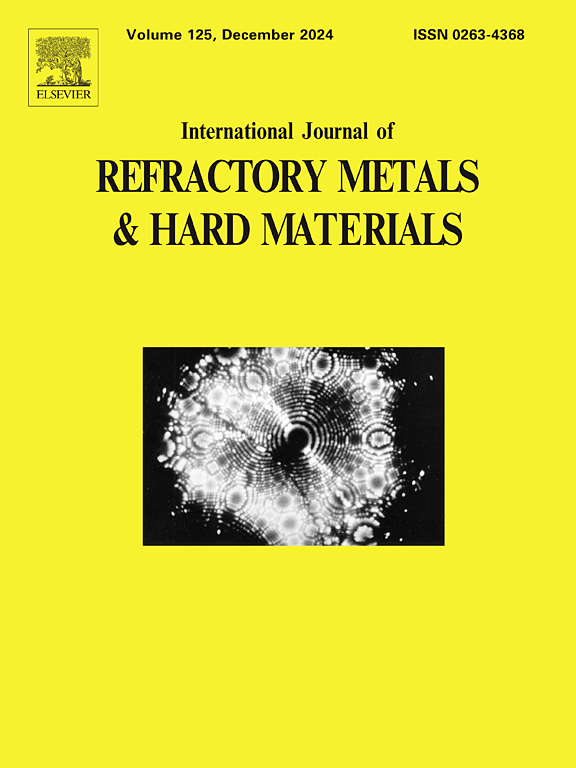浸渗法制备MMC (WC-W-Ni/Fe)的显微组织、力学性能和磨损性能
IF 4.6
2区 材料科学
Q2 MATERIALS SCIENCE, MULTIDISCIPLINARY
International Journal of Refractory Metals & Hard Materials
Pub Date : 2025-06-14
DOI:10.1016/j.ijrmhm.2025.107291
引用次数: 0
摘要
采用Cu-10Ni-6Sn结合剂合金在1180℃下浸润WC-5 W-5Ni多孔预制体制备WC-W-Ni-Fe复合材料。研究了添加铁对复合材料微观组织演变和摩擦学性能的影响。渗渗产生了致密的材料,其微观结构由WC和W₂C碳化物组成,分布在由富cu相和NiSn金属间化合物组成的双相金属基体中。铁颗粒部分溶解于粘结剂中,在固态加热过程中增强了颗粒的重排,导致WC和W形成环状分布。然而,Ni和Fe均引起碳化物的部分脱碳,并有利于脆性(Fe,Ni)₃W₃C η相的析出,这种析出主要发生在粘结剂/碳化物界面和热致裂纹中。干滑动条件下的摩擦学测试表明,含铁复合材料的耐磨性优于不含铁复合材料,尽管形成了η相。这种增强是由于粘合剂的延展性增加,以及在滑动过程中保护表面的裂缝诱导碎屑的形成。本文章由计算机程序翻译,如有差异,请以英文原文为准。
Microstructure, mechanical performance and wear behaviour of MMC (WC-W-Ni/Fe) obtained by infiltration
WC-W-Ni-Fe composites were fabricated by infiltrating WC-5 W-5Ni porous preforms with a Cu-10Ni-6Sn binder alloy at 1180 °C. The study focused on the effects of Fe addition on the microstructural evolution and tribological performance of the composites. The infiltration produced dense materials with a heterogeneous microstructure composed of WC and W₂C carbides distributed within a dual-phase metallic matrix consisting of a Cu-rich phase and a Ni![]() Sn intermetallic compound. The partial dissolution of Fe particles into the binder, enhanced particle rearrangement during solid-state heating, and led to the formation of ring-shaped WC and W distributions. However, both Ni and Fe induced partial decarburization of the carbides and favoured the precipitation of brittle (Fe,Ni)₃W₃C η-phase, preferentially at binder/carbide interfaces and within thermally induced cracks. Tribological testing under dry sliding conditions revealed that Fe-containing composites exhibited improved wear resistance than Fe-free composites, despite the formation of η-phase. The enhancement was attributed to an increased binder ductility and the formation of fracture-induced debris that protected the surface during sliding.
Sn intermetallic compound. The partial dissolution of Fe particles into the binder, enhanced particle rearrangement during solid-state heating, and led to the formation of ring-shaped WC and W distributions. However, both Ni and Fe induced partial decarburization of the carbides and favoured the precipitation of brittle (Fe,Ni)₃W₃C η-phase, preferentially at binder/carbide interfaces and within thermally induced cracks. Tribological testing under dry sliding conditions revealed that Fe-containing composites exhibited improved wear resistance than Fe-free composites, despite the formation of η-phase. The enhancement was attributed to an increased binder ductility and the formation of fracture-induced debris that protected the surface during sliding.
求助全文
通过发布文献求助,成功后即可免费获取论文全文。
去求助
来源期刊
CiteScore
7.00
自引率
13.90%
发文量
236
审稿时长
35 days
期刊介绍:
The International Journal of Refractory Metals and Hard Materials (IJRMHM) publishes original research articles concerned with all aspects of refractory metals and hard materials. Refractory metals are defined as metals with melting points higher than 1800 °C. These are tungsten, molybdenum, chromium, tantalum, niobium, hafnium, and rhenium, as well as many compounds and alloys based thereupon. Hard materials that are included in the scope of this journal are defined as materials with hardness values higher than 1000 kg/mm2, primarily intended for applications as manufacturing tools or wear resistant components in mechanical systems. Thus they encompass carbides, nitrides and borides of metals, and related compounds. A special focus of this journal is put on the family of hardmetals, which is also known as cemented tungsten carbide, and cermets which are based on titanium carbide and carbonitrides with or without a metal binder. Ceramics and superhard materials including diamond and cubic boron nitride may also be accepted provided the subject material is presented as hard materials as defined above.

 求助内容:
求助内容: 应助结果提醒方式:
应助结果提醒方式:


